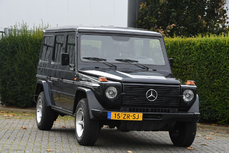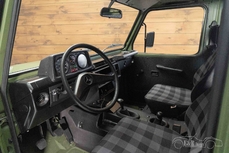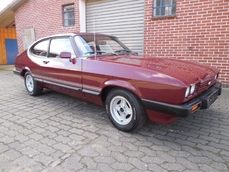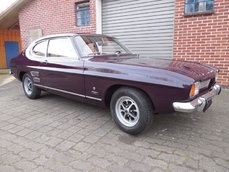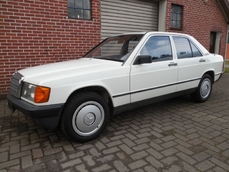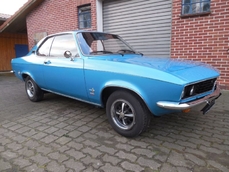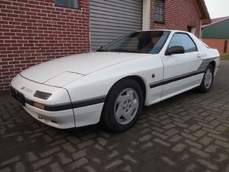Mercedes-Benz G-wagon 1979
General description :
Achtung : Emails werden nicht beantwortet. Ernsthafte Interessenten werden gebeten anzurufen. Bitte nur fachkundige Interessenten.
280 GE lange Version
Mit gesunder Substanz. Das Chassis, die Federaufnahmen und der Boden sehen gut aus. Nicht so zugeschmiert wie die meisten alten G-Klassen.
Natürlich ist der Wagen nicht 100% rostfrei, z.B. Rost hinten links um die Rückleuchte und an ein paar kleineren Stellen die übliche Blasenbildung. Die Grundsubstanz ist wie gesagt aber gut.
Auch die Sitze sind nicht kaputt. Der Motor klingt auch gesund.
Da es sich um ein 37 Jahre altes Fahrzeug handelt, sind natürlich auch Mängel vorhanden, z.B. rechter Außenspiegel abgebrochen, Heizungsgebläse ohne Funktion, Macken an der Türverkleidung, großer Service fällig usw..............
Also nichts für Neuwagenkäufer. Fahrzeuge im Zustand 2+ kosten das dreifache.
Laut Vorbesitzer sollen die 90000 Km. stimmen, da aber keine Belege vorhanden sind, geben wir keine Garantie dafür. 5-Stelliger Tacho. Können also auch 190000 oder 10000090000 Km. sein.
Tüv ist abgelaufen. Verkauf im Istzustand an Fachleute. Bitte keine Oldtimerlaien, die glauben, dass es für diesen Preis ein Zustand 1- Fahrzeug gibt.
Der Wagen hat ein 5-Gang-Getriebe, Servolenkung, 2 Sperren, Heckflügeltüren, Notsitze hinten, Alufelgen mit sehr guten Reifen, CD-Radio, usw.
Emails werden nicht beantwortet. Interessenten werden gebeten anzurufen unter 04794-962356 oder 0160-8521355
Garantie ist bei Fahrzeugen in diesem Alter nicht möglich, deshalb nur an Käufer die dieses akzeptieren. Das muss nicht bedeuten, dass diese Fahrzeuge schlecht oder fehlerhaft sind. Oft sind die älteren Fahrzeuge sogar pflegeleichter, weil sie von moderner Elektronik verschont geblieben sind.
Hier wird niemand " über den Tisch gezogen ". Falls Mängel an einem Fahrzeug bekannt sind, wird dieses auch an den Käufer weitergegeben.
Alle Angaben ohne Gewähr und rein subjektiv, Irrtümer vorbehalten.
Fahrzeugbesichtigung nur nach telefonischer Vereinbarung. Die Fahrzeuge stehen auf abgeschlossenem Gelände.
1979 Mercedes-Benz G-wagon is listed for sale on ClassicDigest in Bremer Str.33 ( Ecke Stelljesdamm )DE-27442 Karlshöfen by Firma T.K.-Mobile for €12900.
Car Facts
Car type : Truck Make : Mercedes-Benz Model : G-wagon Engine size : 2.7 Model Year : 1979 Sub type : Pick up Location : Bremer Str.33 ( Ecke Stelljesdamm )DE-27442 Karlshöfen Vehicle Registration : Undefined
12900 €
People who viewed this Mercedes-Benz G-wagon also viewed similar Mercedes-Benz listed at ClassicDigest
Other cars listed for sale by this dealer
About Mercedes-Benz
In the annals of automotive history, the journey of Mercedes-Benz is a tale that unfolds with the ingenuity of its founding pioneers. In the year 1886, Karl Benz crafted the Benz Patent Motorwagen, a creation that would go down in history as the world's inaugural automobile. Unbeknownst to him, this moment marked the genesis of what would evolve into the most illustrious premium car manufacturer globally. The financial underpinning of this pioneering venture, interestingly, was provided by Karl Benz's wife, Bertha Benz, demonstrating a remarkable partnership that would set the tone for Mercedes-Benz's legacy.A parallel narrative emerged not far away, as Daimler-Motoren-Gesellschaft, founded by Gottlieb Daimler and Wilhelm Maybach, entered the scene. In 1901, they unveiled their automobile under the now-famous moniker "Mercedes," meaning "godsend" in Spanish. This name was bestowed upon the car at the behest of Emil Jellinek's daughter, the distributor for Daimler-Motoren-Gesellschaft. The wheels of innovation were set in motion.
Fast forward to 1926, a pivotal year that witnessed the merger of Daimler with Benz & Cie., culminating in the birth of Daimler-Benz. The amalgamation saw the adoption of "Mercedes-Benz" as the distinguished trademark for their automobiles, fusing the legacies of two visionary entities into one.
Contrary to perceptions of conservatism, the trajectory of Daimler-Benz unfolds as a chronicle of industry firsts. From the introduction of the honeycomb radiator to the float carburetor, and the pioneering implementation of four-wheel brakes in 1924, Daimler-Benz consistently pushed the boundaries of automotive innovation. The diesel-powered Mercedes-Benz 260 D in 1936 marked the inception of diesel engines in passenger cars. The iconic Mercedes-Benz 300SL Gullwing made history as the first car with direct fuel injection, albeit the Gutbrod's tiny 2-stroke engine can claim precedence.
Safety innovations became a hallmark, with Béla Barényi's patented safety cell design in the "Ponton"-models in 1951, featuring front and rear crumple zones. The W116 450SEL 6.9 saw the introduction of the Anti-Lock Brake system (ABS), another pioneering safety feature. From the first production airbags and beyond, the legacy of "firsts" continued to be etched into the fabric of Daimler-Benz.
Over its centennial journey, Mercedes-Benz has not merely produced cars but has sculpted automotive icons. The SSKL, 710 SSK Trossi Roadster, 770K Grosser, 540K Spezial Roadster, 300SL Gullwing, w100 600 Pullman, w111 280SE 3.5 Flachkühler, w113 230SL Pagoda, w109 300 SEL 6.3, and w201 2.3-16 Cosworth stand testament to the brand's commitment to engineering excellence.
The roaring Silver Arrows, or "Silberpfeile," including the W 25, W 125, W154, W165, and W196, created a legacy of dominance on the racetrack. These machines were not merely cars; they were expressions of precision, speed, and an indomitable spirit that left their competitors in the dust.
As Mercedes-Benz marches into the future, it does so not just as an automaker but as a custodian of a legacy, a torchbearer of innovation, and a beacon of automotive excellence. The road ahead is sure to witness the continued fusion of cutting-edge technology, timeless design, and an unwavering commitment to setting new standards in the world of automobiles.
One luminary figure who left an indelible mark was Béla Barényi, often heralded as the "father of passive safety" for his pioneering work in safety engineering. His patented safety cell design, featuring front and rear crumple zones, became a hallmark of Mercedes-Benz's commitment to occupant safety, setting new standards that reverberated throughout the automotive world.
Moving through the chronicles, the collaborative genius of Wilhelm Maybach, alongside Gottlieb Daimler, laid the foundation for Daimler-Motoren-Gesellschaft. Their innovations not only birthed the first Mercedes but established a culture of relentless pursuit of technological excellence that remains integral to Mercedes-Benz's DNA.
In the post-merger era of 1926, Ferdinand Porsche emerged as a prominent figure within Mercedes-Benz. His work on the Mercedes-Benz S-Type, a supercharged race car, garnered acclaim and set the stage for a legacy that extended far beyond the marque. Porsche's impact would later extend to his eponymous company, but his influence at Mercedes-Benz during those formative years was pivotal.
As the 20th century progressed, the legendary Rudolf Uhlenhaut emerged as a key figure. Uhlenhaut, an accomplished engineer and the driving force behind the iconic Silver Arrows, played a crucial role in Mercedes-Benz's dominance in motorsports. His engineering prowess and attention to detail were instrumental in creating some of the most formidable racing cars of the era.
In the latter half of the century, figures like Bruno Sacco, the head of design at Mercedes-Benz from 1975 to 1999, left an indelible imprint on the brand's aesthetic identity. Sacco's design philosophy, characterized by clean lines and timeless elegance, shaped iconic models like the W126 S-Class and the W201 190E, solidifying Mercedes-Benz's reputation for luxury and sophistication.
The narrative would be incomplete without acknowledging the contributions of engineers like Hans Scherenberg, whose leadership in the 1970s ushered in a new era of technological innovation at Mercedes-Benz. Scherenberg's tenure saw the development of groundbreaking technologies, including the Anti-Lock Brake system (ABS) and the introduction of airbags in production cars.
















